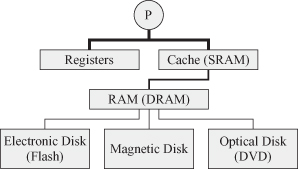2.4 USING MEMORY HIERARCHY
An ideal memory, which is not available yet, should possess several attributes:
1. Nonvolatile so that memory contents are not lost when power is turned off
2. Short access time to match processor speed so that memory load and store operations do not require several clock cycles to complete
3. Large capacity to be able to store massive amounts of data
4. Inexpensive both in terms of the silicon real estate area they require and in price since many data have to be stored
Such an ideal memory does not exist yet. Several memory technologies exist that satisfy some of the above attributes but not all of them simultaneously. The system designer must build the computer storage requirements using a memory hierarchy to take advantage of each memory technology as shown in Fig. 2.3. The types of storage technologies used by current processors are
- registers;
- cache;
- RAM; and
- mass storage, such as magnetic, optical, and flash drives.
Figure 2.3 Memory hierarchy.

The processor talks directly to the fastest memory module available, which is the registers and the cache memory. The only problem is that these two memory modules do not have a large capacity and are expensive to build.
The interconnection pattern of the memory hierarchy is such that each memory module shown in the figure communicates with the neighboring modules connected to it by the shown lines. Data ...
Get Algorithms and Parallel Computing now with the O’Reilly learning platform.
O’Reilly members experience books, live events, courses curated by job role, and more from O’Reilly and nearly 200 top publishers.

